
Monday 30th January 2006, Almerimar, Costa de Almeria
This morning we left our hosts at home and drove through endless acres of plastic greenhouses without a blade of grass between them, to Roquetas de Mar, a pleasant little town with a port and old castle some 20 kilometres further round the coast towards Almería. Our route took us alongside a marshy, reed-covered nature reserve where egrets and water fowl could be found amidst the decaying pieces of plastic sheeting blown into the reeds from the greenhouses during seasonal storms. It did not look a very attractive area and the straight roads between the endless walls of white plastic were potholed and waterlogged from the recent rains.
In Roquetas we parked Modestine by the old fort on the harbour. This is a very pleasant area with the sun shining on the white boats and bright blue sea while the esplanade is edged with grass and mature palm trees with splashes of colour from flowering shrubs.
 The old fort, Roquetas
The old fort, Roquetas The lighthouse with the fort behind, Roquetas
The lighthouse with the fort behind, RoquetasSomeone once said to us that Spain would be a very nice place once it was finished. This looks like taking a very long time. It appears that taxes are only paid on domestic properties once the second floor of the building has been completed. We have often noticed that the ground floor may be beautifully built and occupied and so too might the third, but the second floor is quite likely to be nothing but bare supporting columns, wiring, cement bags and builders rubble. People then live in the property for years, never completing the work, thus avoiding any tax on the property.
 Tax evasion, Roquetas
Tax evasion, RoquetasModern Spanish towns are generally not very interesting places to explore, being little more than commercial centres and building sites. So many in southern Spain seem entirely functional and devoid of beauty, culture or interest. Internet shops, pharmacies and restaurants we have found in abundance, but little in the way of churches, art galleries or museums. Building construction is far better now than used to be the case and property developers have learned from their mistakes. The coastal towns are no longer high rise but there is still massive over-development and some of the older properties are now looking quite dilapidated with horrible electric wiring cascading down looking dangerous and aesthetically unpleasant.
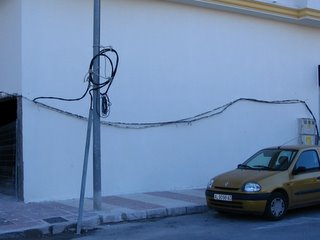 Functional but unattractive domestic wiring so typical of Spain, Roquetas
Functional but unattractive domestic wiring so typical of Spain, RoquetasIn general Roquetas and its urban suburbs were actually quite pleasant however. Far bigger than Almerimar it has some very nice white rendered residential properties with flowering gardens in quiet roads leading back from the sea. We walked along the sea front where dozens of Dutch and German visitors cycled along on their tiny folding bikes like Hinge and Bracket. All the cafes had tables by the beach and menus in German, Dutch and English. We chanced on an English restaurant and enjoyed a beer and tapas in the fresh sunshine, right near the sea, followed by prawn jacket potatoes and mixed salad. Although we feel wrong enjoying English food in southern Spain, it is excellent quality and delicious whereas the local food does not greatly inspire us. It seemed odd being served by a nice English lady in a pink cardie, almost as if we were in Margate or Blackpool!
 A Brit on the Costa, Roquetas
A Brit on the Costa, Roquetas View along the beach, Roquetas
View along the beach, RoquetasLater we discovered a shop selling purely British goods with a sign over the door reading “Arkrights, Open all hours”. Here we browsed amongst the marmite and marmalade and treated ourselves to a tin of Heinz baked beans! There is an enormous resident British community here. It is a real home from home and it would be quite possible to live here and never really need to speak Spanish to anyone! In addition there are the migratory Germans, British and Dutch who come here for the winter in their camping cars and live together on all year camp sites.
 Home and away, Roquetas
Home and away, RoquetasWe returned along the potholed roads to Almerimar passing huge refuse skips by the roadside filled with courgettes and tomatoes being thrown away, presumably because they had failed the quality test. Stopping at a garden centre on the edge of Almerimar we were served by a Dutch lady speaking excellent English. She suggested a couple of patio plants to select as a “thank you” to Jane and Gerry for taking us in as a couple of soaking waifs during the rains and sheltering us until we had dried out.
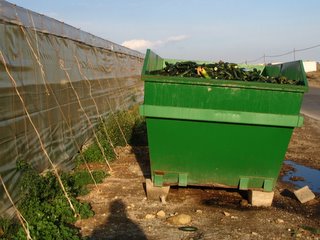 Rejected vegetables, Roquetas
Rejected vegetables, RoquetasTuesday 31sr January 2006, Torre del Mar, Costa del Sol
This morning was warm and sunny. We packed up and prepared to move on. But Modestine was having none of it! For the second time we found ourselves with a puncture!! We couldn’t believe our eyes! It wasn’t even the same wheel! Five top quality tyres purchased within the last month and two of them punctured already! Fortunately we were still in Almerimar and the puncture turned out to be a slow one so we pumped it up and drove to the local tyre specialist. Here Modestine was too tall to get under the barrier and the tyre people sent us off to a trading estate where there was a Michelin tyre agent. Somehow we never end up with things being straightforward but we are proud to say we managed everything entirely in Spanish and even worked out how to find the tyre place from the Spanish directions we were given. Ian in particular is doing amazingly well though we feel rather helpless at times.
In seconds a huge, vicious nail was found embedded in Modestine’s tyre! We watched in great admiration as the puncture was repaired and the wheel replaced. It cost us a mere 8 euros! Worth that for the Spanish practice alone! So we were on our way with none of the horrors of a few days ago in Valencia, but we still felt quite shocked by it all.
 Modestine in difficulty, El Ejido
Modestine in difficulty, El EjidoSo we set off along the coast towards Malaga. This route runs right along the southern coast with the reddy-brown bare landscape of mountains capped with snow on the landward side and the beautiful sparking blue of the sea on the other. The route gets more hilly and twisting beyond Motril and Salobreña where sugar cane is grown on the marshland beside the coast. We stopped briefly at Salobreña, a pueblo blanco (white town) built steeply up the hillside with views down onto the sugar cane plantations.
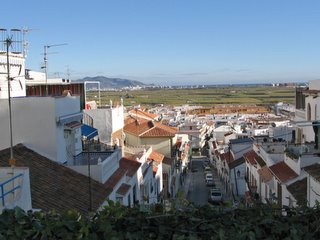 Salobreña with sugar plantations beyond
Salobreña with sugar plantations beyondWe have actually been uncomfortably warm at times during the day and this evening we are on a campsite at Torre del Mar right by the sea. We arrived at sunset and sat outside Modestine under the orange blossom for our evening wine as the sun sank into the sea and a bat skimmed around us catching invisible insects. Later, outside in the darkness frogs are croaking in the marshes. Yes, here it really is lovely but somehow we don’t warm to the Spanish landscape which is impressive but very harsh.
“Brits to the right of us, Brits to the left …” This site is huge and absolutely full of English, German and Dutch people who are here for the season. There are massive discounts for people staying for 2 or 3 months and most appear to be doing just that. There are washing lines, awnings, bicycles and potted plants surrounding most of the huge camping vans here. There are piles of paperback books left by the sinks in the laundry for people to exchange. For us it is pleasant and convenient to stay here for the night. Everyone is quiet and friendly. However, you have really got to want sun badly to give up the comfort of a home in England and drive a huge van down here every year, as most people do, to live tightly packed with your neighbours, sharing communal facilities, on the edge of an ugly town with nothing but a sandy beach to recommend it. It’s probably great for learning languages though. You might go home speaking excellent German or Dutch but you’d not make much progress in Spanish!
Wednesday 1st February 2006, Marbella, Costa del Sol
We have really found the sun at last! We haven’t used our fan heater and have dispensed with one of our duvets! We’ve not needed pullovers or coats all day and temperatures at Torremolinos were well into the 20s.
This morning we walked into the town of Torre del Mar along the seafront where already wintering migrants were gathered on café terraces with beers or coffees. All around us we could hear German or English being spoken. There were thousands of happy campers, all of retirement age around the town and the sea front and it was an experience we would certainly not have missed. In the showers German ladies mumbled together as they scrubbed their false teeth in the wash basins and adjusted their hearing aids (yes it’s true), while at the sinks English men recounted tales of how they had been here for the last four months for the ninth year running! Folk sat together all day in the sunshine outside each others camper vans and seemed quite content to pass weeks hardly seeming to leave the campsite! One English lady had come over on a denture venture to have her teeth fixed as it was so much cheaper than back in England!
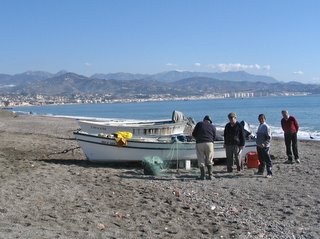 Fishermen on the beach, Torre del Mar
Fishermen on the beach, Torre del MarWe moved on mid morning, skirting Malaga on the motorway. Malaga is a very nice town as we discovered in 2004 when we spent several nights there just before Christmas visiting the superb botanic gardens, the Alcazabar and Gibralfaro high above the port and the bull ring. We also visited the Picasso museum which we did not at all appreciate. (We will link this account of Malaga to our blogsite at a later date.) Today though, we wanted to move further along the coast to Torremolinos. This, along with Benidorm, have generally been regarded as the worst in1960s and 70s Spanish coastal development. Having passed through Torremolinos on the bus last April on our way to visit our daughter Kate in Cadiz we felt it may have been misjudged. So we turned off into the town which is really very big, crowded with English people, bars, tourist shops, hotels and apartments. However, it is spotlessly clean, well maintained with flowers, shrubs and greenery to brighten the sunny streets and a beautiful stretch of clean sandy beach, almost empty today despite the warm sunshine. Everything is recent but it has a definite quality to it and is infinitely nicer than most of the modern coastal resorts or almost any of the southern Spanish towns we have seen – Torremolinos is to all intents and purposes a British town where even the signs are all in English! There is however, the smart, tranquil Plaza de Europa with a powerful statue of Zeus, disguised as a bull, rushing away with Europa on his back, having fallen in love and captured her. The statue was unveiled in 2005.
 The English abroad, Torremolinos
The English abroad, Torremolinos Zeus and Europa, Torremolinos
Zeus and Europa, TorremolinosParking is the greatest problem in Torremolinos and Modestine nearly got damaged when a Belgian driver reversed into her. Fortunately we found the horn in a hurry and received no more than a glancing blow to the bumper. With the tyres, that makes the third incident over the last few days so we hope it will be the last.
The coastal route along from here to Marbella becomes very busy, almost a motorway with hotels, flats, restaurants, golf courses and real estate along the entire length with tantalising glimpses of the blue Mediterranean between the endless holiday apartment blocks. Just before Marbella we turned off at a campsite we believed to be open. Fortunately it was, so we are now staying within distant earshot of the roaring traffic heading between Algeciras and Malaga but in a pine forest with a view of the sunset on the mountains of the Sierra Nevada.
 Selling dreams along the highway, Marbella
Selling dreams along the highway, MarbellaHaving found the site we realised we couldn’t continue to Marbella as we’d almost certainly never find our way back here again from the arterial coastal road, travelling in the opposite direction with turn-off lanes few and far between. So we crossed the road by a high overhead footbridge and walked through a delightful residential area of very select and very Spanish villas set in beautiful grounds with strong wrought iron gates and impressive looking security systems. This is obviously where the wealthy live, and many of these too are English or German!
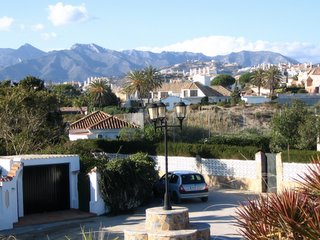 Residential property near Marbella
Residential property near Marbella Spain’s answer to garden gnomes, Marbella
Spain’s answer to garden gnomes, Marbella Winter blossoms, Marbella
Winter blossoms, MarbellaDown on the beach we wandered along the sand amongst the dunes sprinkled with cactuses and palm trees with the magnificent Sierra Nevada dark and rugged against the stunning blue of the sky. Behind the dunes were the ubiquitous apartment blocks and holiday villas but on the empty beach it was easy to ignore them.
 Empty beach near Marbella
Empty beach near MarbellaWe sat outside Modestine this evening with our wine, the sun still warm at 7pm and realised at last what it is that lures everyone south for the winter. If it never gets warmer than today, we will be perfectly happy.
Thursday 2nd February 2006, Ronda, Andalucia
It was warm enough to move outside of Modestine for breakfast which we enjoyed in bright sunshine with views across the tops of the pine trees to the Mediterranean in one direction and up to the hard brown mountains of the Sierra Blanca in the other.
Last time we stayed at Malaga we took the bus to Marbella and found the old town to be quaint, well kept, full of pretty shady alleys between whitewashed little houses, the fronts crowded with flowers. This time though, we were in a camping car and found it quite impossible to stop anywhere in the main town which is modern, stretching right along the seafront and very crowded. In the end we decided to give Marbella a miss and head up into the hills to escape from the tourist sprawl right along the Costa del Sol from Almerima to Marbella.
So we headed up towards Ronda, relieved to leave the brash crowded coastal resorts behind. Here there was far less traffic and the route wound its way steeply up, bend after bend for nearly fifty kilometres, the scenery becoming more arid and bare as we climbed. Vistas, wide and wild opened to our left with a solid wall of grey and yellow rock to our right. Neither of us has ever experienced a landscape quite so empty and barren before. At times there was not even a leaf to relieve the monotony of the dry bare, rugged landscape, certainly no sign of human habitation. Eventually we reached the snowline with patches of white in the crevices or tumbled down in frozen heaps beside the road. Up here, on the roof of the world at 1060 metres we discovered several wild brown and black goats. We also found a couple of tiny waterfalls formed from the melting snow. They will never reach the torrentos and rias down on the coast however. These have now ceased to exist in all but name. So massive is the demand for water in the coastal towns, all the rivers have been diverted to cope and the mountainous hinterland has been ecologically destroyed, turning the sierra into a barren desert where nothing but a few hardy goats and the eagles seem able to survive.
 Sierra Bermeja from the route up to Ronda
Sierra Bermeja from the route up to Ronda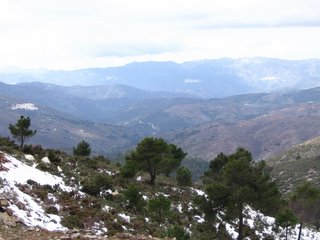 The route up to Ronda with a pueblo blanco in the distance
The route up to Ronda with a pueblo blanco in the distanceEventually the road evened out and descended gently down into the old mountain city of Ronda, nestling in verdant valleys in the midst of this inhospitable landscape, its white walled houses prominent against the grey hillsides. Many of the mountain towns and villages in Andalucia are whitewashed to reflect the sun’s heat. They are known as pueblos blancos and from within they are cool and attractive. From a distance however, Jill thinks they look like huge untidy piles of old newspapers dumped on the hillsides.
 Ronda with its Moorish defences
Ronda with its Moorish defences Ronda perched on the clifftop
Ronda perched on the clifftopWe visited Ronda on an impulse by bus just over a year ago when we found ourselves, also by chance, in Seville. On that occasion we had to contend with ceaseless rain but were captivated by the town. Our return visit, particularly after the cultural desert of Spain’s southern coast, confirmed our impression that Ronda truly is an attractive historical town with much to offer.
Built on the edge of a precipice the town has two distinct parts linked by a bridge across a deep ravine with a small river and waterfall tumbling far below. Views from the edge of the town and from the bridge are stunning with the ground falling away sheer on all sides to a wide valley floor, the mountains rising again beyond. From this bridge, during the Spanish civil war, various resistance fighters were thrown to their deaths sickeningly far below.
 The Puente Nuevo with its waterfall, Ronda
The Puente Nuevo with its waterfall, Ronda The Puente Nuevo from the Jardines de Cuenca, Ronda
The Puente Nuevo from the Jardines de Cuenca, Ronda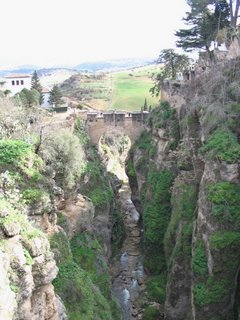 The Puente Viejo from the Jardines de Cuenca, Ronda
The Puente Viejo from the Jardines de Cuenca, RondaRonda is also famed as the cradle of modern bull fighting and has what is considered to be the most beautiful bull ring in Spain. Here in the 18th century the rules for bull fighting were laid down by Pedro Romero and his successors who founded a school for the training of matadors. Amongst the many museums on offer, is one of bullfighting.
 Outside the Bullring, Ronda
Outside the Bullring, Ronda Pedro Romero in the Alameda del Tajo gardens, Ronda
Pedro Romero in the Alameda del Tajo gardens, RondaThe town retains its magnificent ancient walls with defensive towers and gateways. Within, the narrow streets between the whitewashed houses are cobbled and there are public gardens, where spring flowers and blossoms are already appearing, offering either vistas from the cliff edge to the horizon, or following the rocky riverside steeply down in a series of steps and terraces beneath shady pine trees, palms and cactus plants, the air filled with the sound of tiny invisible birds hidden in the branches. Several of Ronda’s most magnificent palaces and casas have become museums with beautiful, tiled internal courtyards filled with plants and fountains.
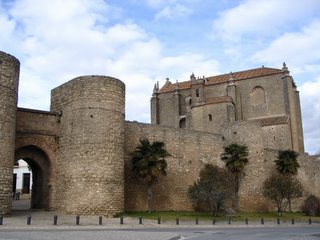 Puerta de Almocábar and Iglesia del Espíritu Santo, Ronda
Puerta de Almocábar and Iglesia del Espíritu Santo, Ronda A typical street in the old town, Ronda
A typical street in the old town, Ronda Palacio Mondragón, now the town museum, Ronda
Palacio Mondragón, now the town museum, Ronda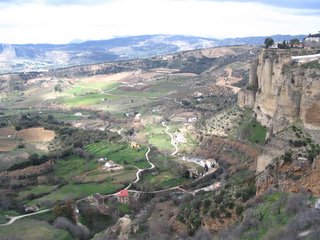 View over the precipice from the public gardens, Ronda
View over the precipice from the public gardens, RondaOriginally a muslim town with an Alcazar and defensive walls, Ronda fell to the Christians in 1485. There is therefore a strong Mudéjar influence in architectural style, particularly on certain churches, for example, the 15th century minaret of St. Sebastian. Below the town the Arab baths can still be visited, the most complete in Spain with vaulted roofs lit by star-shaped openings. (We visited these on our previous visit and will eventually link that account to this blog.)
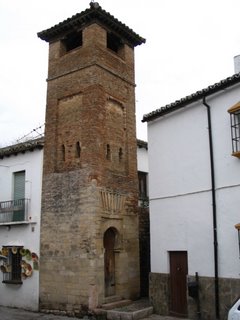 The minaret of St. Sebastian, Ronda
The minaret of St. Sebastian, Ronda Remains of the Alcazar, Ronda
Remains of the Alcazar, Ronda Remains of the 13th century Arab Baths, Ronda
Remains of the 13th century Arab Baths, Ronda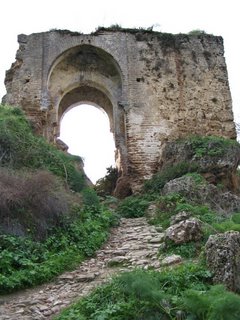 Arab fortifications below the Puente Nuevo, Ronda
Arab fortifications below the Puente Nuevo, RondaThe day passed all too quickly. We were walking around all day but still feel there is more to take in than time permitted. Towards evening the air turned very chilly so high up in the mountains, though down at sea level it is probably as warm as last night. Just outside the town we found a very nice campsite, as quiet and deserted as those down on the Costa del Sol were crowded and brash. Why everyone prefers to be down there rather than enjoying this stunning inland scenery, the clean air and cultural joys of Ronda is hard to understand. The atmosphere along the coast needed to be experienced but we are glad to have it behind us and now look forward to experiencing more of the beauty and culture Spain has to offer.
Below are a few more of Ronda’s treasures.
 Iglesia de Nuestro Padre Jesús, Ronda
Iglesia de Nuestro Padre Jesús, Ronda Neoclassical town hall with orange trees, Ronda
Neoclassical town hall with orange trees, Ronda Convento de la Merced, Ronda
Convento de la Merced, RondaAnd finally …..
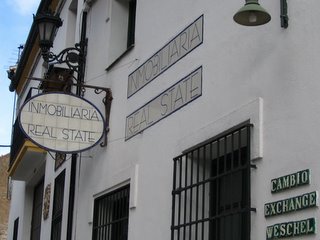 Linguistic shortcomings in English and German, Ronda
Linguistic shortcomings in English and German, Ronda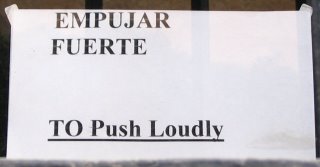 Entry sign on the door of the above estate agent, Ronda
Entry sign on the door of the above estate agent, Ronda